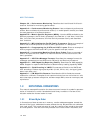
Vol. 3 2-1
CHAPTER 2
SYSTEM ARCHITECTURE OVERVIEW
IA-32 architecture (beginning with the Intel386 processor family) provides extensive
support for operating-system and system-development software. This support offers
multiple modes of operation, which include:
• Real mode, protected mode, virtual 8086 mode, and system management mode.
These are sometimes referred to as legacy modes.
Intel 64 architecture supports almost all the system programming facilities available
in IA-32 architecture and extends them to a new operating mode (IA-32e mode) that
supports a 64-bit programming environment. IA-32e mode allows software to
operate in one of two sub-modes:
• 64-bit mode supports 64-bit OS and 64-bit applications
• Compatibility mode allows most legacy software to run; it co-exists with 64-bit
applications under a 64-bit OS.
The IA-32 system-level architecture and includes features to assist in the following
operations:
• Memory management
• Protection of software modules
• Multitasking
• Exception and interrupt handling
• Multiprocessing
• Cache management
• Hardware resource and power management
• Debugging and performance monitoring
This chapter provides a description of each part of this architecture. It also describes
the system registers that are used to set up and control the processor at the system
level and gives a brief overview of the processor’s system-level (operating system)
instructions.
Many features of the system-level architectural are used only by system program-
mers. However, application programmers may need to read this chapter and the
following chapters in order to create a reliable and secure environment for applica-
tion programs.
This overview and most subsequent chapters of this book focus on protected-mode
operation of the IA-32 architecture. IA-32e mode operation of the Intel 64 architec
-
ture, as it differs from protected mode operation, is also described.
All Intel 64 and IA-32 processors enter real-address mode following a power-up or
reset (see
Chapter 9, “Processor Management and Initialization”). Software then


















